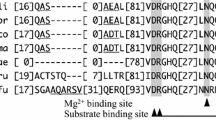Abstract
AXenopus laevis peptidyl C-terminal α-amidating enzyme (AE-II) gene, modified by deletion of a region encoding the putative membrane-spanning domain and the putative C-terminal cytosolic tail, was expressed in BoMo-15 AIIc insect cells and silkworm larvae using aBombyx mori baculovirus expression vector system. The expressed enzyme was identified predominantly in the culture medium and the hemolymph of silkworm larvae, indicating successful secretion of the expressed AE-II. The level of recombinant enzyme in the larval hemolymph at 4 days post-infection (40 μg/ml) was more than 100-fold the peak levels found in the culture medium (250 ng/ml). The enzyme activity in the larval hemolymph at 4 days post-infection was 3700 units/ml.
Similar content being viewed by others
References
Beaudry AG and Bertelsen HA (1989) Secreted alpha amidating enzyme are generated by specific post-translation processing of precursors containing transmembrane domains. Biochem. Biophys. Res. Commun. 163: 959–966.
Inoue H, Taniai K and Kobayashi J (1990) Establishment and characterization of substrate depending cell lines ofBombyx mori. Bull. Natl. Inst. Seric. Entomol. Sci. 1: 13–25 (in Japanese with English summary).
Kato I, Yonekura H, Tajima M, Yanagi M, Yamamoto H and Okamoto H (1990) Two enzymes concerned in peptide hormone-amidation are synthesized from a single mRNA. Biochem. Biophys. Res. Commun. 163: 197–203.
Kobayashi J, Inoue H, Katoh I, Yoshinaka Y and Ikawa Y (1990) Construction of a new baculovirus vector system of the silkworm,Bombyx mori. In: HH Hagedorn, JG Hildebrand, MG Kidwell and JH Law (eds.) Molecular Insect Science, Plenum, New York, NY, p. 325.
Luckow VA and Summers MD (1988) Trends in the development of baculovirus expression vectors. Bio/Technology 6: 47–55.
Maeda S (1989) Gene transfer vectors of a baculovirus,Bombyx mori nuclear polyhedrosis virus, and their use for expression of foreign genes in insect cells. In: J Mitsuhashi (ed.) Invertebrate Cell System Applications, CRC Press, Boca Raton, FL, pp. 167–181.
Maeda S (1989a) Expression of foreign genes in insects using baculovirus vectors. Ann. Rev. Entomol. 34: 351–372.
Maeda S, Kawai T, Obinata M, Fujiwara H, Horiuchi T, Saeki Y, Sato Y and Furusawa M (1985) Production of human α-interferon in silkworm using a baculovirus vector. Nature 315: 592–594.
Matsuura Y, Possee RD, Overton HA and Bishop DHL (1987) Baculovirus expression vectors: the requirements for high level expression of proteins, including glycoproteins. J. Gen. Virol. 68: 1233–1250.
Miller LK (1988) Baculovirus as gene expression vectors. Ann. Rev. Microbiol. 42: 177–199.
Mitsuhashi J (1984) Isolation of continuous cell line from larval fat bodies of an artiid moth,Spilartia seriatopunctata, (Insecta, Lepidoptera, Arctiidae) Zool. Sci. 1: 415–419.
Miyajima A, Scheurs J, Otsu K, Kondo A, Arai K and Maeda S (1987) Use of the silkwormBombyx mori, an insect baculo-virus vector for high-level expression and secretion of biologically active mouse interleukin-3. Gene 58: 273–281.
Mizuno K, Sakata J, Kojima M, Kangawa K and Matsuo H (1986) Peptide C-terminal α-amidating enzyme purified to homogeneity fromXenopus laevis skin. Biochem. Biophys. Res. Commun. 137: 984–991.
Mizuno K, Ohsuye K, Wada Y, Fuchimura K, Tanaka S and Matsuo H (1987) Cloning and sequencing of cDNA encoding a peptide C-terminal α-amidating enzyme fromXenopus laevis. Biochem. Biophys. Res. Commun. 148: 546–552.
Ohsuye K, Kitano K, Wada Y, Fuchimura K, Tanaka S, Mizuno K and Matsuo H (1988) Cloning of cDNA encoding a new peptide C-terminal α-amidating enzyme having a putative membrane-spanning domain fromXenopus laevis skin. Biochem. Biophys. Res. Commun. 150: 1275–1281.
Suzuki K, Shimoi H, Iwasaki Y, Kawahara T, Matsuura Y and Nishikawa Y (1990) Elucidation of amidating reaction mechanism by frog amidating enzyme, peptidylglycine α-hydroxylating monooxygenase, expressed in insect cell culture. EMBO J. 9: 4259–4265.
Tsujimoto M, Adachi H, Kodama S, Tsuruoka N, Yamada Y, Tanaka S, Mita S and Takatsu K (1989) Purification and characterization of recombinant human interleukin 5 expressed in Chinese hamster ovary cells. J. Biochem. 106: 23–28.
Author information
Authors and Affiliations
Rights and permissions
About this article
Cite this article
Kobayashi, J., Imanishi, S., Inoue, H. et al. High level expression of a frog α-amidating enzyme, AE-II, in cultured cells and silkworm larvae using aBombyx mori nuclear polyhedrosis virus expression vector. Cytotechnology 8, 103–108 (1992). https://doi.org/10.1007/BF02525492
Received:
Accepted:
Issue Date:
DOI: https://doi.org/10.1007/BF02525492




